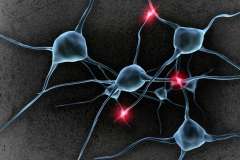Time Cells in the Brain
Fall 2020

When we move through our day or our world, we remember the sequences of events, sensations, thoughts and actions. It is good to close the refrigerator after returning the milk carton. That lost cell phone will turn up somewhere, if only we could remember where we put it. Dr. Peyman Golshani, Professor of Neurology, has wondered how brain cells (neurons) remember. He and his team used brain imaging of neurons during tasks of remembering in mice. The imaging revealed two distinct types of neurons. One set of cells responded to the odors, while a second set of cells, referred to as “time cells,” marked the passage of time after the mice sensed the odor. As the seconds went by, the activity passed through a sequence of such time-sensing neurons, effectively indicating how much time had elapsed since the first odor. The time-sensing cells could reorganize in response to changing conditions. “If you extend the delay from 5 seconds to 10 seconds, time cells will completely change their activity,” says Dr. Jianni Taxidis, the lead author in the study. “If you look at these neurons the next day, the odor cells will be there, but the time cells will have lost their timing activity, and new time cells will have emerged.” The number of time cells increased as the mice learned to remember and compare the odor information, their brains recruiting more and more neurons to help with that task.
This work sets the stage for future studies on how the coordinated firing of neurons represents not just the timing notations that we put on sensory events, but how neuronal firing relates to the perception of time itself. We perceive moments of time with a duration---and this perception of time can be influenced directly by our brain state. Time can be passing slowly or apparently moving quickly. The sense of time influences our ability to keep focused on an event, which apparently is declining in the smartphone era. If our perception of reality is what reality actually is, future research on coordinated neuronal firing may be able to alter time itself.
Adapted from an article on Dr. Golshani’s work from Caroline Seydel, Neurology and UCLA Health Science writer.